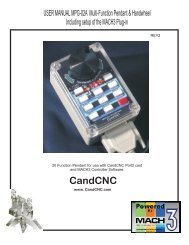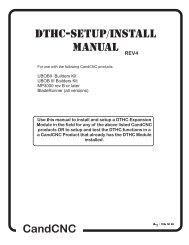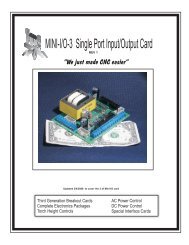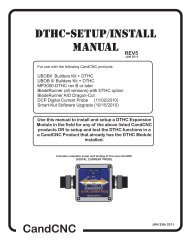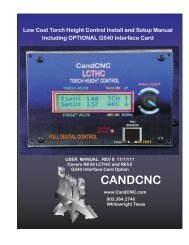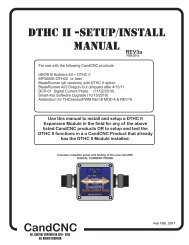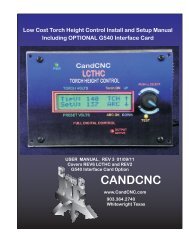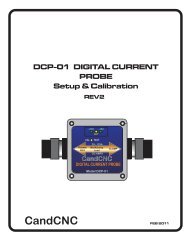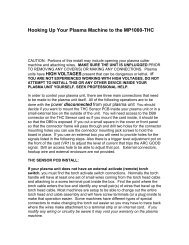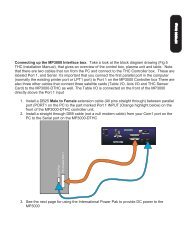Create successful ePaper yourself
Turn your PDF publications into a flip-book with our unique Google optimized e-Paper software.
Once you have the motors moving the right direction and the right distance then<br />
you should go through a tuning procedure to optimize the machine movements.<br />
1. Start by doubling your max VELOCITY on the X and Y axis<br />
NOTE: If you are using a 4 motor setup and software slaving you're A axis to X or<br />
Y then you need to provide both motors with the same velocity and acceleration<br />
numbers. While the Steps per Unit should match you can change that slightly to<br />
account for mechanical mismatches. Do not run different gears or belt reduction<br />
ratios on a slaved axis or you will have a lot of problems getting them to exactly<br />
match.<br />
TESTING<br />
2. Use the calibration technique of typing in a move in the MDI (G00 move) to a<br />
point then measure the error. Keep raising both Velocity and Acceleration for each<br />
axis by about 20% jumps. At the point you hear the motors start to grind or you<br />
start losing position,(or getting a drive fault on a servo system) write down the<br />
settings. Back off 20% first on velocity. You would like to have as much<br />
acceleration as you can maintain at an acceptable velocity. If you still get lost steps<br />
or drive faults then lower the acceleration by 20% and try again.<br />
3. Once you have one axis tuned use the same settings on any axis that has the<br />
same motor and gearing and run the tests. You can move it up or down but having<br />
a Y that is twice as fast as X won’t help much in normal moves since it only moves<br />
as fast as the slowest axis during a coordinated move.<br />
4. The Z is normally tuned and calibrated differently than the horizontal axis. Often<br />
the Z uses a leadscrew and the calculations are easier. For Gecko’s it’s 2000 times<br />
the number of threads per inch = Steps per Unit. The constant 2000 is the motor<br />
steps times the microstepping (200 * 10). For servos we supply the encoder line<br />
count is 500. That produces 2000 pulses per rev so the numbers work the same.<br />
You may find you have to increase the MACH Kernel Speed (Ports & Pins main<br />
tab) so you can get enough steps per unit to hit higher velocities.<br />
If you plan on using your machine for Torch Height Control or for 3D carving having<br />
a fast Z is an advantage. You want to have speed but also good resolution. Make<br />
the Z feed too course and the THC moves can be ragged and cause overshoot. A<br />
good resolution is about .001 per step (.025mm). A velocity of at least 150 IPM is a<br />
target but speeds of at least the velocity of X an Y let you cut 3D a lot faster.<br />
Steppers only spin about 600 to 800 RPM lifting the Z so to get 150IPM your<br />
leadscrew needs to not be finer than 5 TPI.



